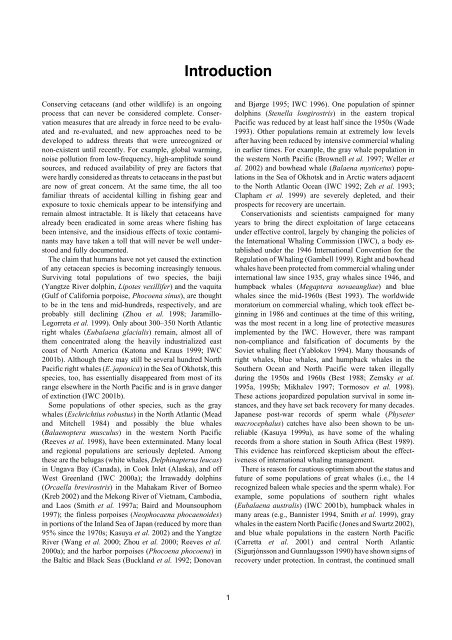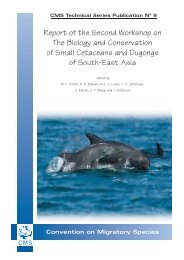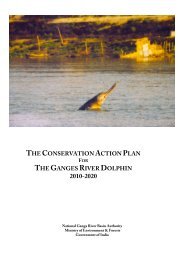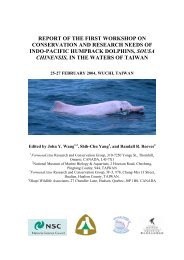Dolphins, Whales and Porpoises: 2002-2010 Conservation - IUCN
Dolphins, Whales and Porpoises: 2002-2010 Conservation - IUCN
Dolphins, Whales and Porpoises: 2002-2010 Conservation - IUCN
You also want an ePaper? Increase the reach of your titles
YUMPU automatically turns print PDFs into web optimized ePapers that Google loves.
Introduction<br />
Conserving cetaceans (<strong>and</strong> other wildlife) is an ongoing<br />
process that can never be considered complete. <strong>Conservation</strong><br />
measures that are already in force need to be evaluated<br />
<strong>and</strong> re-evaluated, <strong>and</strong> new approaches need to be<br />
developed to address threats that were unrecognized or<br />
non-existent until recently. For example, global warming,<br />
noise pollution from low-frequency, high-amplitude sound<br />
sources, <strong>and</strong> reduced availability of prey are factors that<br />
were hardly considered as threats to cetaceans in the past but<br />
are now of great concern. At the same time, the all too<br />
familiar threats of accidental killing in fishing gear <strong>and</strong><br />
exposure to toxic chemicals appear to be intensifying <strong>and</strong><br />
remain almost intractable. It is likely that cetaceans have<br />
already been eradicated in some areas where fishing has<br />
been intensive, <strong>and</strong> the insidious effects of toxic contaminants<br />
may have taken a toll that will never be well understood<br />
<strong>and</strong> fully documented.<br />
The claim that humans have not yet caused the extinction<br />
of any cetacean species is becoming increasingly tenuous.<br />
Surviving total populations of two species, the baiji<br />
(Yangtze River dolphin, Lipotes vexillifer) <strong>and</strong> the vaquita<br />
(Gulf of California porpoise, Phocoena sinus), are thought<br />
to be in the tens <strong>and</strong> mid-hundreds, respectively, <strong>and</strong> are<br />
probably still declining (Zhou et al. 1998; Jaramillo-<br />
Legorreta et al. 1999). Only about 300–350 North Atlantic<br />
right whales (Eubalaena glacialis) remain, almost all of<br />
them concentrated along the heavily industrialized east<br />
coast of North America (Katona <strong>and</strong> Kraus 1999; IWC<br />
2001b). Although there may still be several hundred North<br />
Pacific right whales (E. japonica) in the Sea of Okhotsk, this<br />
species, too, has essentially disappeared from most of its<br />
range elsewhere in the North Pacific <strong>and</strong> is in grave danger<br />
of extinction (IWC 2001b).<br />
Some populations of other species, such as the gray<br />
whales (Eschrichtius robustus) in the North Atlantic (Mead<br />
<strong>and</strong> Mitchell 1984) <strong>and</strong> possibly the blue whales<br />
(Balaenoptera musculus) in the western North Pacific<br />
(Reeves et al. 1998), have been exterminated. Many local<br />
<strong>and</strong> regional populations are seriously depleted. Among<br />
these are the belugas (white whales, Delphinapterus leucas)<br />
in Ungava Bay (Canada), in Cook Inlet (Alaska), <strong>and</strong> off<br />
West Greenl<strong>and</strong> (IWC 2000a); the Irrawaddy dolphins<br />
(Orcaella brevirostris) in the Mahakam River of Borneo<br />
(Kreb <strong>2002</strong>) <strong>and</strong> the Mekong River of Vietnam, Cambodia,<br />
<strong>and</strong> Laos (Smith et al. 1997a; Baird <strong>and</strong> Mounsouphom<br />
1997); the finless porpoises (Neophocaena phocaenoides)<br />
in portions of the Inl<strong>and</strong> Sea of Japan (reduced by more than<br />
95% since the 1970s; Kasuya et al. <strong>2002</strong>) <strong>and</strong> the Yangtze<br />
River (Wang et al. 2000; Zhou et al. 2000; Reeves et al.<br />
2000a); <strong>and</strong> the harbor porpoises (Phocoena phocoena) in<br />
the Baltic <strong>and</strong> Black Seas (Buckl<strong>and</strong> et al. 1992; Donovan<br />
<strong>and</strong> Bjørge 1995; IWC 1996). One population of spinner<br />
dolphins (Stenella longirostris) in the eastern tropical<br />
Pacific was reduced by at least half since the 1950s (Wade<br />
1993). Other populations remain at extremely low levels<br />
after having been reduced by intensive commercial whaling<br />
in earlier times. For example, the gray whale population in<br />
the western North Pacific (Brownell et al. 1997; Weller et<br />
al. <strong>2002</strong>) <strong>and</strong> bowhead whale (Balaena mysticetus) populations<br />
in the Sea of Okhotsk <strong>and</strong> in Arctic waters adjacent<br />
to the North Atlantic Ocean (IWC 1992; Zeh et al. 1993;<br />
Clapham et al. 1999) are severely depleted, <strong>and</strong> their<br />
prospects for recovery are uncertain.<br />
<strong>Conservation</strong>ists <strong>and</strong> scientists campaigned for many<br />
years to bring the direct exploitation of large cetaceans<br />
under effective control, largely by changing the policies of<br />
the International Whaling Commission (IWC), a body established<br />
under the 1946 International Convention for the<br />
Regulation of Whaling (Gambell 1999). Right <strong>and</strong> bowhead<br />
whales have been protected from commercial whaling under<br />
international law since 1935, gray whales since 1946, <strong>and</strong><br />
humpback whales (Megaptera novaeangliae) <strong>and</strong> blue<br />
whales since the mid-1960s (Best 1993). The worldwide<br />
moratorium on commercial whaling, which took effect beginning<br />
in 1986 <strong>and</strong> continues at the time of this writing,<br />
was the most recent in a long line of protective measures<br />
implemented by the IWC. However, there was rampant<br />
non-compliance <strong>and</strong> falsification of documents by the<br />
Soviet whaling fleet (Yablokov 1994). Many thous<strong>and</strong>s of<br />
right whales, blue whales, <strong>and</strong> humpback whales in the<br />
Southern Ocean <strong>and</strong> North Pacific were taken illegally<br />
during the 1950s <strong>and</strong> 1960s (Best 1988; Zemsky et al.<br />
1995a, 1995b; Mikhalev 1997; Tormosov et al. 1998).<br />
These actions jeopardized population survival in some instances,<br />
<strong>and</strong> they have set back recovery for many decades.<br />
Japanese post-war records of sperm whale (Physeter<br />
macrocephalus) catches have also been shown to be unreliable<br />
(Kasuya 1999a), as have some of the whaling<br />
records from a shore station in South Africa (Best 1989).<br />
This evidence has reinforced skepticism about the effectiveness<br />
of international whaling management.<br />
There is reason for cautious optimism about the status <strong>and</strong><br />
future of some populations of great whales (i.e., the 14<br />
recognized baleen whale species <strong>and</strong> the sperm whale). For<br />
example, some populations of southern right whales<br />
(Eubalaena australis) (IWC 2001b), humpback whales in<br />
many areas (e.g., Bannister 1994, Smith et al. 1999), gray<br />
whales in the eastern North Pacific (Jones <strong>and</strong> Swartz <strong>2002</strong>),<br />
<strong>and</strong> blue whale populations in the eastern North Pacific<br />
(Carretta et al. 2001) <strong>and</strong> central North Atlantic<br />
(Sigurjónsson <strong>and</strong> Gunnlaugsson 1990) have shown signs of<br />
recovery under protection. In contrast, the continued small<br />
1





